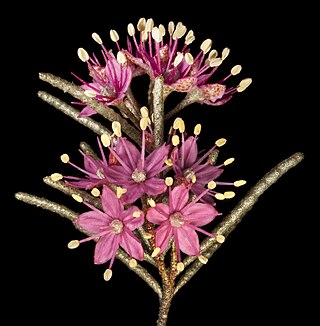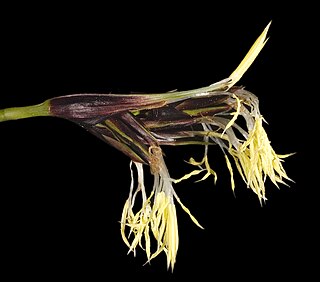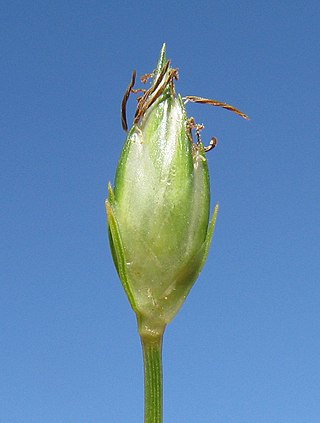
In the botanical classification of plants, Aeridinae Pfitzer is a subtribe of the tribe Vandeae whose representatives all have a monopodial growth habit and do not possess pseudobulbs.

The Cyperaceae are a family of graminoid (grass-like), monocotyledonous flowering plants known as sedges. The family is large: botanists have described some 5,500 known species in about 90 genera, the largest being the "true sedges" with over 2,000 species.

Rhynchospora is a genus of about 400 species of sedges with a cosmopolitan distribution. The genus includes both annual and perennial species, mostly with erect 3-sided stems and 3-ranked leaves. The achenes bear a beak-like tubercule and are sometimes subtended by bristles. Many of the species are similar in vegetative appearance, and mature fruits are needed to make a positive identification.

Phebalium is a genus of thirty species of shrubs or small trees in the family Rutaceae and is endemic to Australia. The leaves are arranged alternately, simple and often warty, the flowers arranged singly or in umbels on the ends of branchlets or in leaf axils, usually with five sepals, five petals and ten stamens. There are about thirty species and they are found in all Australian states but not in the Northern Territory.

Eleocharis is a virtually cosmopolitan genus of 250 or more species of flowering plants in the sedge family, Cyperaceae. The name is derived from the Greek words ἕλειος (heleios), meaning "marsh dweller," and χάρις (charis), meaning "grace." Members of the genus are known commonly as spikerushes or spikesedges. The genus has a geographically cosmopolitan distribution, with centers of diversity in the Amazon Rainforest and adjacent eastern slopes of the South American Andes, northern Australia, eastern North America, California, Southern Africa, and subtropical Asia. The vast majority of Eleocharis species grow in aquatic or mesic habitats from sea level to higher than 5,000 meters in elevation.

Fimbristylis is a genus of sedges. A plant in this genus may be known commonly as a fimbry or fimbristyle. There are 200 to 300 species distributed worldwide. Several continents have native species but many species have been introduced to regions where they are not native. Some are considered weeds. These are typical sedges in appearance, with stiff, ridged stems and cone-shaped terminal panicles of spikelets. They are found in wet environments, and are most diverse in tropical and subtropical regions.

Lepidosperma is a genus of flowering plant of the family Cyperaceae. Most of the species are endemic to Australia, with others native to southern China, southeast Asia, New Guinea, New Caledonia and New Zealand.

Gahnia is a genus of sedges native to China, Southeast Asia, New Guinea, Australia, New Zealand and a number of Pacific Islands. The common name is due to the toothed margins. It often forms tussocks.

Schoenus is a predominately austral genus of sedges, commonly known as bogrushes, or veldrushes in South Africa. Species of this genus occur mainly in South Africa, Australia and Southeast Asia. Others are found in scattered locations worldwide, from Europe to Asia, North Africa and the Americas. Three species occur in the peatlands of southern South America, including S. antarcticus which is found in Tierra del Fuego, where it forms a component of hyperhumid Magellanic moorland.
Actinoschoenus is a genus of the sedge family, which includes around five species native to Australia.
Jeremy James Bruhl is an Australian botanist. He is an emeritus professor in the School of Environmental and Rural Science at the University of New England and director of the N.C.W. Beadle Herbarium which holds c.110,000 plant specimens.

Tetraria is a genus of flowering plants in the sedge family, Cyperaceae, native to Tanzania, South Africa, Borneo, Australia and New Zealand.
Karen Louise Wilson is an Australian botanist.
Russell Lindsay Barrett is an Australian botanist.
Walwhalleya is a genus of flowering plants belonging to the family Poaceae. All members use C3 photosynthesis
Anthelepis is a genus of flowering plants belonging to the family Cyperaceae.

Morelotia is a genus of flowering plants belonging to the family Cyperaceae. It contains six species of sedges native to New Zealand, the Hawaiian Islands, Tubuai Islands, and Western Australia.

Abildgaardia ovata, synonyms including Abildgaardia monostachya and Fimbristylis ovata, is a perennial herb of the genus Abildgaardia and the family Cyperaceae. It is a widespread species that can be found in West, Southern and East Africa, Florida, Mexico, the Caribbean and in some countries of Latin America.











